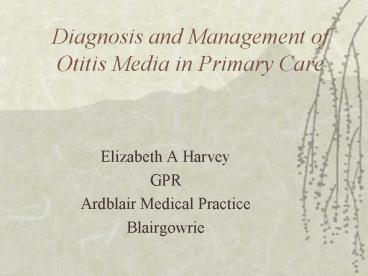Diagnosis and Management of Otitis Media in Primary Care - PowerPoint PPT Presentation
1 / 27
Title:
Diagnosis and Management of Otitis Media in Primary Care
Description:
Acute otitis media has a favourable natural history regardless of antibiotic use ... If an antibiotic is to be prescribed, a 5 day course is recommended at dosage ... – PowerPoint PPT presentation
Number of Views:1401
Avg rating:3.0/5.0
Title: Diagnosis and Management of Otitis Media in Primary Care
1
Diagnosis and Management of Otitis Media in
Primary Care
- Elizabeth A Harvey
- GPR
- Ardblair Medical Practice
- Blairgowrie
2
Anatomy of the Ear
3
Normal Ear
4
Acute Otitis Media
- Inflammation of the middle ear of rapid onset
presenting most often with local symptoms
(commonly earache and rubbing or tugging of the
infected ear) and systemic signs (such as fever,
irritability and poor sleep). - There may be a preceding history of upper
respiratory symptoms including cough and
rhinorrhoea.
5
Facts and Figures
- Cause of great morbidity in children
- 75 of all cases of acute otitis media occur in
children under the age of 10 years - 25 of children will have at least one episode of
acute otitis media before their 10th birthday - Peak incidence of diagnosis between ages of 3 and
6 - Streptococcus pneumoniae, Haemphilius influenzae
and Moraxella catarrhalis most common bacterial
causes
6
Risk Factors
- Young age
- Attendance at nursery or school
- Caucasian
- Male sex
- History of enlarged adenoids, tonsils
- History of asthma
- Multiple previous episodes
- Bottle feeding
- History in parents or siblings
7
Diagnosis
- Acute Otitis Media
- Earache
- Fever
- Irritability
- Middle ear effusion
- Opaque drum
- Possible bulging drum
- Impaired drum mobility
- Hearing loss
8
Complications of Acute Otitis Media
- Mastoiditis
- Labyrinthitis
- Facial Palsy
- Meningitis
- WHO estimates that each year 51,000 children
under age of 5 years die from complications in
developing countries
- Subdural abscess
- Extradural abscess
- Brain abscess
- Petrositis
9
Management
- In the majority of cases, acute otitis media is
self limiting - However, studies have shown on average 97
receive antibiotics
10
Antibiotic Usage
- Some studies suggest that antibiotics reduce
- the time to cessation of fever by 24 hours
- the time to cessation of pain or crying by 24
hours
11
However
- Acute otitis media has a favourable natural
history regardless of antibiotic use - A meta-analysis of studies conducted concluded
that the overall rate of spontaneous resolution
of acute otitis media was 81 percent - Side effects of antibiotics not to be forgotten
- Most commonly Gastrointestinal upset rash
12
Acute Otitis Media- SIGN
- Children diagnosed with acute otitis media should
not routinely be prescribed antibiotics as the
initial treatment - If an antibiotic is to be prescribed, a 5 day
course is recommended at dosage levels indicated
by the BNF - Children with acute otitis media media should not
be prescribed decongestants or antihistamines - Parents should give paracetamol for reducing pain
in children with acute otitis media
13
Referral for Acute Otitis Media
- Children with frequent episodes (more than four
in six months) of acute otitis media, should be
referred to ENT
14
Otitis Media with Effusion
- Inflammation of the middle ear, accompanied by
the accumulation of fluid in the middle ear cleft
without the signs and symptoms of acute
inflammation. OME is often asymptomatic, and
earache is relatively uncommon
15
Facts and Figures
- Otitis media with effusion glue ear is also
prevalent - About 80 of children are reported to have otitis
media with effusion before the age of 4 years - Otitis media with effusion has important
implications for child development
16
Diagnosis
- Otitis media with effusion
- No earache
- No fever
- No irritability
- Middle ear effusion
- Not always opaque drum
- Not usually a bulging drum
- Impaired drum mobility
- Usually hearing loss
17
Management
- Children with otitis media with effusion should
not be treated with antibiotics - Decongestants, antihistamines and mucolytics
should not be used in the management of OME - The use of topical or systemic steroid therapy is
not recommended - Autoinflation may be of benefit in the management
of some children
18
Autoinflation
- Process by which the Eustachian tube is forced
open to allow drainage of fluid from the middle
ear
19
Using Autoinflation
20
How does Autoinflation Work?
- Aim of nasal balloon is to drain fluid from
middle ear - Once the child stops blowing up the balloon and
breathes normally, the air rushes back up child's
nostril into the eustachian tube - The air pressure from the deflating balloon
forces open the eustachian tube, clearing the
blockage, allowing fluid to drain down throat - Eardrum becomes free of fluid, therefore the
ossicles move easily again, hearing improves
21
Otovent Kit
22
Autoinflation
Prior to Treatment
Post Treatment
23
Referral of Otitis Media with Effusion
- Children with persistent bilateral otitis media
with effusion who are over three years of age or
who have speech and language, developmental or
behavioural problems should be referred to ENT
24
Referral of Otitis Media with Effusion
- Children under three years of age with persistent
bilateral otitis media with effusion and hearing
loss of 25dB, but no speech and language,
developmental or behavioural problems, can be
safely managed by watchful waiting - If watchful waiting is being considered, child
should undergo audiometry to exclude a more
serious form of hearing loss
25
Whilst Waiting for Specialist Opinion
- Discourage passive smoking
- Encourage drinking from a cup not a bottle
- Sit at childs level and keep instructions short
and simple - Reduce background noise whilst talking to the
child - Inform school teachers which ear hears best
26
Surgical Management of OME
- Usually by insertion of a Grommet
27
Questions































